God made the wild animals according to their kinds ...
And God saw that it was good. --
Genesis 1:25 (NIV)
Beaver Den
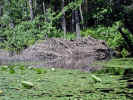
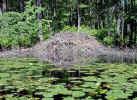 Towne
Pond has a beaver or possibly a beaver family. Pictures of the beaver den are
on the left and right. Its size above water is about 12 (L) x 7 (W) x 5 (H)
feet. Like all beaver dens, the access hole is under water. Beavers are
nocturnal and most commonly seen at dusk swimming across the pond. (If I had a
telescopic lens, maybe I could get a picture of the beaver.) Unlike river
otters, beavers steadily swim with their head above water. At night if one hears
certain sounds (like a human walking around a wooden deck), it makes a surprisingly loud splash with
its tail in order to declare its territory. When I first heard the loud ker-plunk sound, I thought of a
10-pound bowling ball falling out of a tree into the water.
Towne
Pond has a beaver or possibly a beaver family. Pictures of the beaver den are
on the left and right. Its size above water is about 12 (L) x 7 (W) x 5 (H)
feet. Like all beaver dens, the access hole is under water. Beavers are
nocturnal and most commonly seen at dusk swimming across the pond. (If I had a
telescopic lens, maybe I could get a picture of the beaver.) Unlike river
otters, beavers steadily swim with their head above water. At night if one hears
certain sounds (like a human walking around a wooden deck), it makes a surprisingly loud splash with
its tail in order to declare its territory. When I first heard the loud ker-plunk sound, I thought of a
10-pound bowling ball falling out of a tree into the water.
Beaver Dam
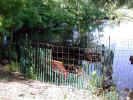
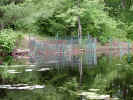 Towne
Pond has one exit for water -- an overflow pipe that is 3 feet in diameter.
This vertical pipe turns 90 degrees and passes through an earthen dam. The
stream that starts at the exit of the pipe is a tributary to Fish Brook in
Boxford. The beaver has repeatedly dammed up the overflow pipe with branches,
pond vegetation, and mud. For years on a weekly basis, the owner of the property
that includes the overflow pipe unclogged the beaver dam. Finally, the owner
hired a company to install "beaver-proof" fencing around the exit
pipe. The photo on the left shows the exit pipe and surrounding fencing. A
grate that is sometimes used over the pipe opening is on edge, tilted toward
the camera. The photo on the right is a view of the same scene from the pond.
This fencing is second generation and the beaver still packs mud and sticks
against the fencing to stop the water flow.
Towne
Pond has one exit for water -- an overflow pipe that is 3 feet in diameter.
This vertical pipe turns 90 degrees and passes through an earthen dam. The
stream that starts at the exit of the pipe is a tributary to Fish Brook in
Boxford. The beaver has repeatedly dammed up the overflow pipe with branches,
pond vegetation, and mud. For years on a weekly basis, the owner of the property
that includes the overflow pipe unclogged the beaver dam. Finally, the owner
hired a company to install "beaver-proof" fencing around the exit
pipe. The photo on the left shows the exit pipe and surrounding fencing. A
grate that is sometimes used over the pipe opening is on edge, tilted toward
the camera. The photo on the right is a view of the same scene from the pond.
This fencing is second generation and the beaver still packs mud and sticks
against the fencing to stop the water flow.
Beaver Trails
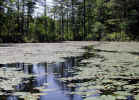 Interestingly,
the beaver has formed trails through the lily pads. All of the trails
originate from the beaver den. One trail goes from the den to the dam. Other
trails head for nearby corners of the pond. The beaver may have actually
uprooted the lily pads along his trails because the pond seems to be deeper on
the trails.
Interestingly,
the beaver has formed trails through the lily pads. All of the trails
originate from the beaver den. One trail goes from the den to the dam. Other
trails head for nearby corners of the pond. The beaver may have actually
uprooted the lily pads along his trails because the pond seems to be deeper on
the trails.
Wood Cutting

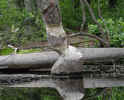 Of
course, beavers cut down hardwood, eat the bark, and use branches for dens and
dams. A fresh example in my yard is shown on the left. Eventually, the beaver
took all of the tree branches and left only the trunk. I found some of the
smaller branches near my dock, stripped of bark. The image on the right, which
I call beaver sculpture, is evidence of various approaches by the
beaver to cut down a tree. Curiously, none of the chipping looks fresh, so
this job apparently fell off the beaver's to-do list.
Of
course, beavers cut down hardwood, eat the bark, and use branches for dens and
dams. A fresh example in my yard is shown on the left. Eventually, the beaver
took all of the tree branches and left only the trunk. I found some of the
smaller branches near my dock, stripped of bark. The image on the right, which
I call beaver sculpture, is evidence of various approaches by the
beaver to cut down a tree. Curiously, none of the chipping looks fresh, so
this job apparently fell off the beaver's to-do list.
Beaver Grave Yard
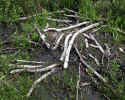 Actually,
these are not beaver bones. I found this scene in the marsh area of the pond.
The branches are 2 to 3 inches in diameter. The ends of the branches were all
clearly chewed by a beaver.
Actually,
these are not beaver bones. I found this scene in the marsh area of the pond.
The branches are 2 to 3 inches in diameter. The ends of the branches were all
clearly chewed by a beaver.